Fatigue Behavior of Alloy Steels Sintered from Pre-Alloyed and Diffusion-Bonding Alloyed Powders
Abstract
1. Introduction
2. Materials and Methods
3. Results and Discussion
3.1. Effects of Porosity on Fatigue Strength
3.2. Effect of Phases on Fatigue Strength
3.3. Fracture Behavior of Fatigue
3.4. Quantitative Analysis of the Effects of Porosity and Phase Constitution on Fatigue Strength
4. Conclusions
Author Contributions
Funding
Institutional Review Board Statement
Informed Consent Statement
Data Availability Statement
Acknowledgments
Conflicts of Interest
References
- German, R.M. Powder Metallurgy Science; Metal Powder Industries Federation: Princeton, NJ, USA, 1984. [Google Scholar]
- Polasik, S.J. Fatigue Crack Initiation and Propagation of Binder-Treated. Metall. Mater. Trans. A 2002, 33, 73–82. [Google Scholar] [CrossRef]
- Bergmark, A.; Alzati, L. Fatigue crack path in Cu–Ni–Mo alloyed PM steel. Fatigue Fract. Eng. Mater. Struct. 2005, 28, 229–235. [Google Scholar] [CrossRef]
- Borges, M.F.; Antunes, F.V.; Prates, P.A.; Branco, R.; Vojtek, T. Effect of Young’s modulus on Fatigue Crack Growth. Int. J. Fatigue 2019, 132, 105375. [Google Scholar] [CrossRef]
- Danninger, H.; Spoljaric, D.; Weiss, B. Microstructural features limiting the performance of P/M steels. Int. J. Powder Metall. 1997, 33, 43–53. [Google Scholar]
- Deng, X.; Piotrowski, G.; Chawla, N.; Narasimhan, K. Fatigue crack growth behavior of hybrid and prealloyed sintered steels Part II. Fatigue behavior. Mater. Sci. Eng. A 2008, 491, 28–38. [Google Scholar] [CrossRef]
- Bergmark, A. Influence of maximum pore size on the fatigue performance of PM steel. Powder Metall. Prog. 2005, 5, 131–137. [Google Scholar]
- Wang, C.L.; Wang, P.; Shi, Z.M. Fatigue Properties for Sinter-Hardened Fe-Ni-Mo-Cu Materials. Mater. Sci. Forum 2007, 534–536, 677–680. [Google Scholar] [CrossRef]
- Mousavinasab, S.; Blais, C. Study of the effect of microstructure heterogeneity on fatigue crack propagation of low-alloyed PM steels. Mater. Sci. Eng. A 2016, 667, 444–453. [Google Scholar] [CrossRef]
- Deng, X.; Piotrowski, G.; Chawla, N.; Narasimhan, K. Fatigue crack growth behavior of hybrid and prealloyed sintered steels Part I. Microstructure characterization. Mater. Sci. Eng. A 2008, 491, 19–27. [Google Scholar] [CrossRef]
- Andersson, O.; Lindqvist, B. Benefits of heterogeneous structures for the fatigue behaviour of PM steels. Met. Powder Rep. 1990, 45, 765–768. [Google Scholar] [CrossRef]
- Srijampan, W.; Wiengmoon, A.; Morakotjinda, M.; Krataitong, R.; Yotkaew, T.; Tosangthum, N.; Tongsri, R. Microstructure and mechanical property of sintered Fe-Cr-Mo steels due to phase transformations with fast cooling rates. Mater. Des. 2015, 88, 693–701. [Google Scholar] [CrossRef]
- Carabajar, S.; Verdu, C.; Hamel, A.; Fougeres, R. Fatigue behaviour of a nickel alloyed sintered steel. Mater. Sci. Eng. A 1998, 257, 225–234. [Google Scholar] [CrossRef]
- Sudhakar, K. Fatigue behavior of a high density powder metallurgy steel. Int. J. Fatigue 2000, 22, 729–734. [Google Scholar] [CrossRef]
- Höganäs, A.B. Höganäs Handbook 1 for Sintered Components; Höganäs AB: Höganäs, Sweden, 2013. [Google Scholar]
- Bergman, O.; Chasoglou, D.; Dahlström, M. Mechanical performance of Cr-alloyed PM steel after different sintering and heat treatment operations. Met. Powder Rep. 2018, 73, 21–25. [Google Scholar] [CrossRef]
- Hryha, E.; Gierl, C.; Nyborg, L. Surface composition of the steel powders pre-alloyed with manganese. Appl. Surf. Sci. 2010, 256, 3946–3961. [Google Scholar] [CrossRef]
- Bergman, O. Influence of oxygen partial pressure in sintering atmosphere on properties of Cr–Mo prealloyed powder metallurgy steel. Powder Metall. 2013, 50, 243–249. [Google Scholar] [CrossRef]
- Verdu, S.C.; Lormand, G.; Fougeres, R. Fatigue crack growth characterization and simulation of a porous steel. Mater. Sci. Eng. A 2001, 319–321, 544–549. [Google Scholar] [CrossRef]
- Abdoos, H.; Khorsand, H.; Shahani, A.R. Fatigue behavior of diffusion bonded powder metallurgy steel with heterogeneous microstructure. Mater. Des. 2009, 30, 1026–1031. [Google Scholar] [CrossRef]
- Drar, H. Metallographic and fractographic examination of fatigue loaded PM-steel with and without MnS additive. Mater. Charact. 2000, 45, 211–220. [Google Scholar] [CrossRef]
- Gerosa, R.; Rivolta, B.; Tavasci, A. Crack initiation and propagation in Chromium pre-alloyed PM-steel under cyclic loading. Eng. Fract. Mech. 2008, 75, 750–759. [Google Scholar] [CrossRef]
- Hatami, S.; Malakizadi, A.; Nyborg, L. Critical aspects of sinter-hardening of prealloyed Cr–Mo steel. J. Mater. Process. Technol. 2010, 210, 1180–1189. [Google Scholar] [CrossRef]
- Dlapka, M.; Danninger, H.; Gierl, C.; Weiss, B.; Khatibi, G.; Betzwar-Kotas, A. Critical defects in different sinter hardening grade steels tested under gigacycle fatigue loading. Powder Metall. Prog. 2011, 11, 69–77. [Google Scholar]
- Engdhal, P. Fatigue behaviour of PM steels-materials aspects. In Word Conference on Powder Metallurgy; Wembly Conference Center: London, UK, 1990; pp. 144–154. [Google Scholar]
- Piotrowski, A.; Biallas, G. Influence of Sintering Temperature on Pore Morphology, Microstructure, and Fatigue Behaviour of MoNiCu Alloyed Sintered Steel. Powder Metall. 1998, 41, 109–114. [Google Scholar] [CrossRef]
- Williams, J.J.; Deng, X.; Chawla, N. Effect of residual surface stress on the fatigue behavior of a low-alloy powder metallurgy steel. Int. J. Fatigue 2007, 29, 1978–1984. [Google Scholar] [CrossRef]
- Kabatova, M.; Dudrova, E.; Wronski, A.S. Microcrack nucleation, growth, coalescence and propagation in the fatigue failure of a powder metallurgy steel. Fatigue Fract. Eng. Mater. Struct. 2009, 32, 214–222. [Google Scholar] [CrossRef]
- Mousavinasab, S.; Blais, C. The influence of different microstructural constituents on the fatigue crack propagation behaviour of a nickel PM steel. Int. J. Fatigue 2017, 99, 44–54. [Google Scholar] [CrossRef]
- Dai, X.; Peng, T.; Chen, Y.F. The correlation between martensite-austenite islands evolution and fatigue behavior of SA508-IV steel. Int. J. Fatigue 2020, 139, 105776. [Google Scholar] [CrossRef]
- Murakami, Y. Metal Fatigue: Effects of Small Defects and Nonmetallic Inclusions; Elsevier Science: Oxford, UK, 2002. [Google Scholar]
- Andersson, M. The role of porosity in fatigue of PM materials. Powder Metall. Prog. 2011, 11, 21–31. [Google Scholar]
- Straffelini, G.; Benedetti, M.; Fontanari, V. Damage evolution in sinter-hardening powder-metallurgy steels during tensile and fatigue loading. Mater. Des. 2014, 61, 101–108. [Google Scholar] [CrossRef]
- Hirose, N.; Tanaka, S.I.; Tanaki, T. Relationships between porosity and elastic modulus of sintered copper-nickel alloys made from mixed and mechanical alloyed powders. Tran. Jpn. Soc. Mech. Eng. Ser. A 2003, 69, 1033–1039. [Google Scholar] [CrossRef][Green Version]
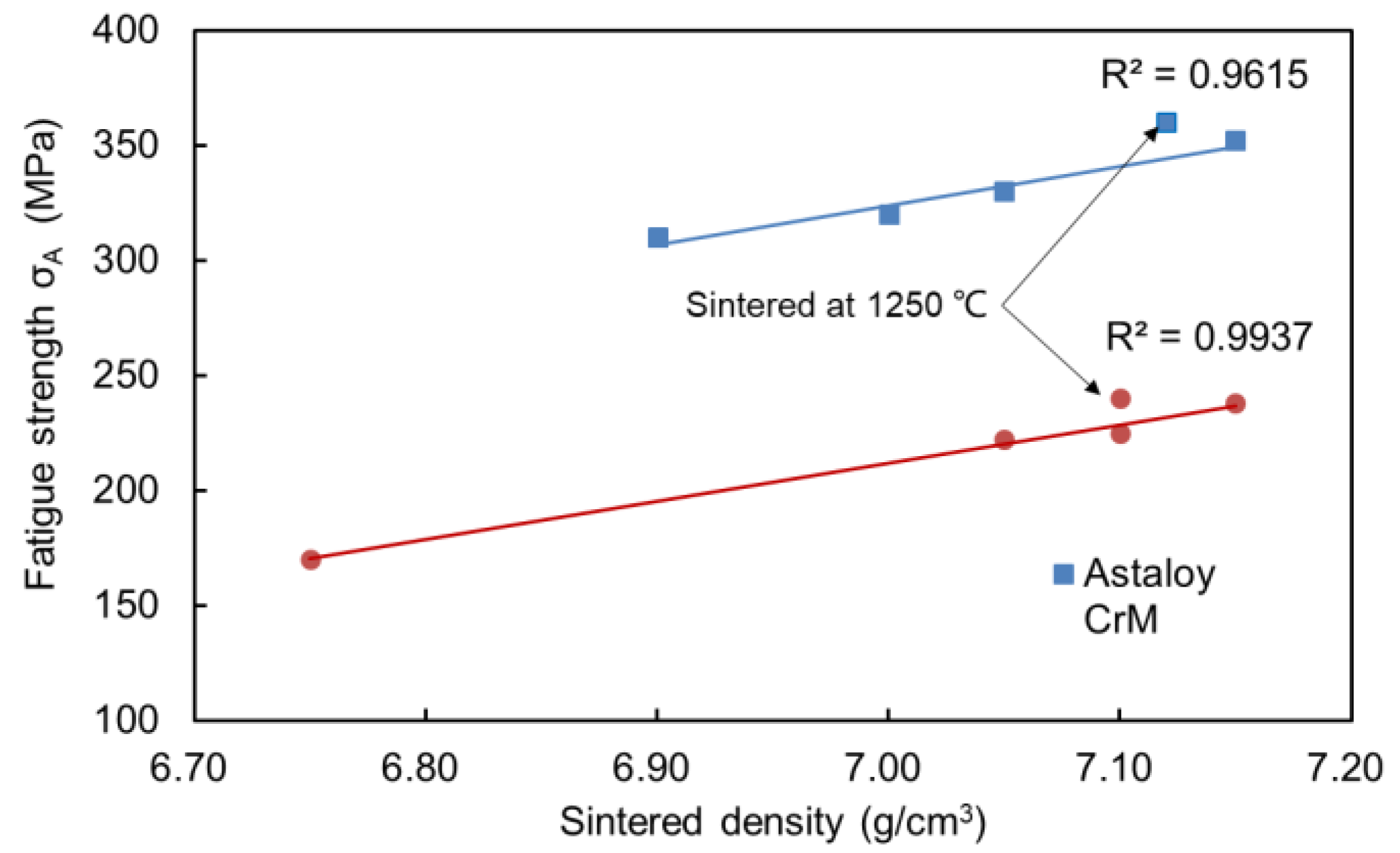


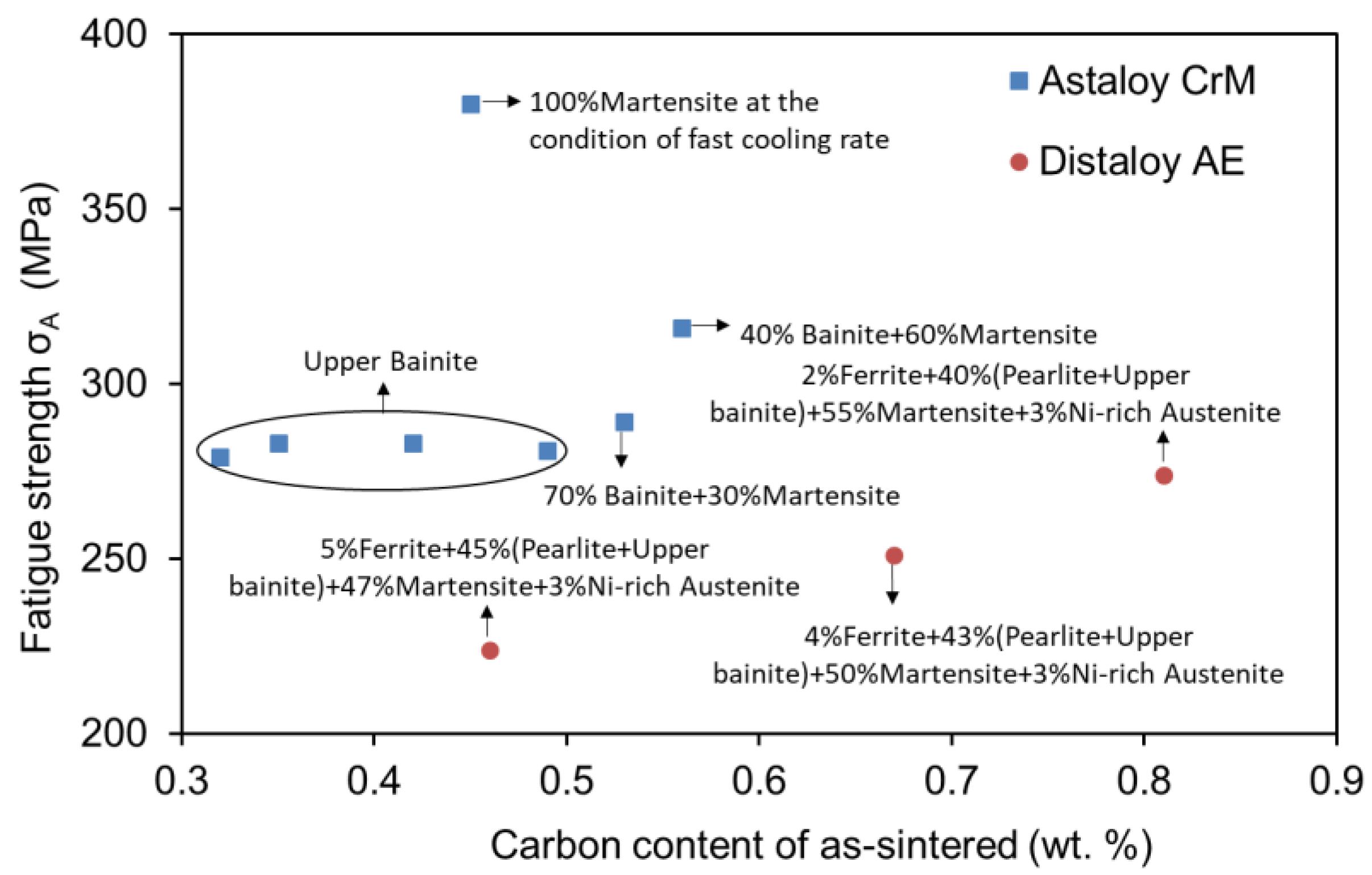

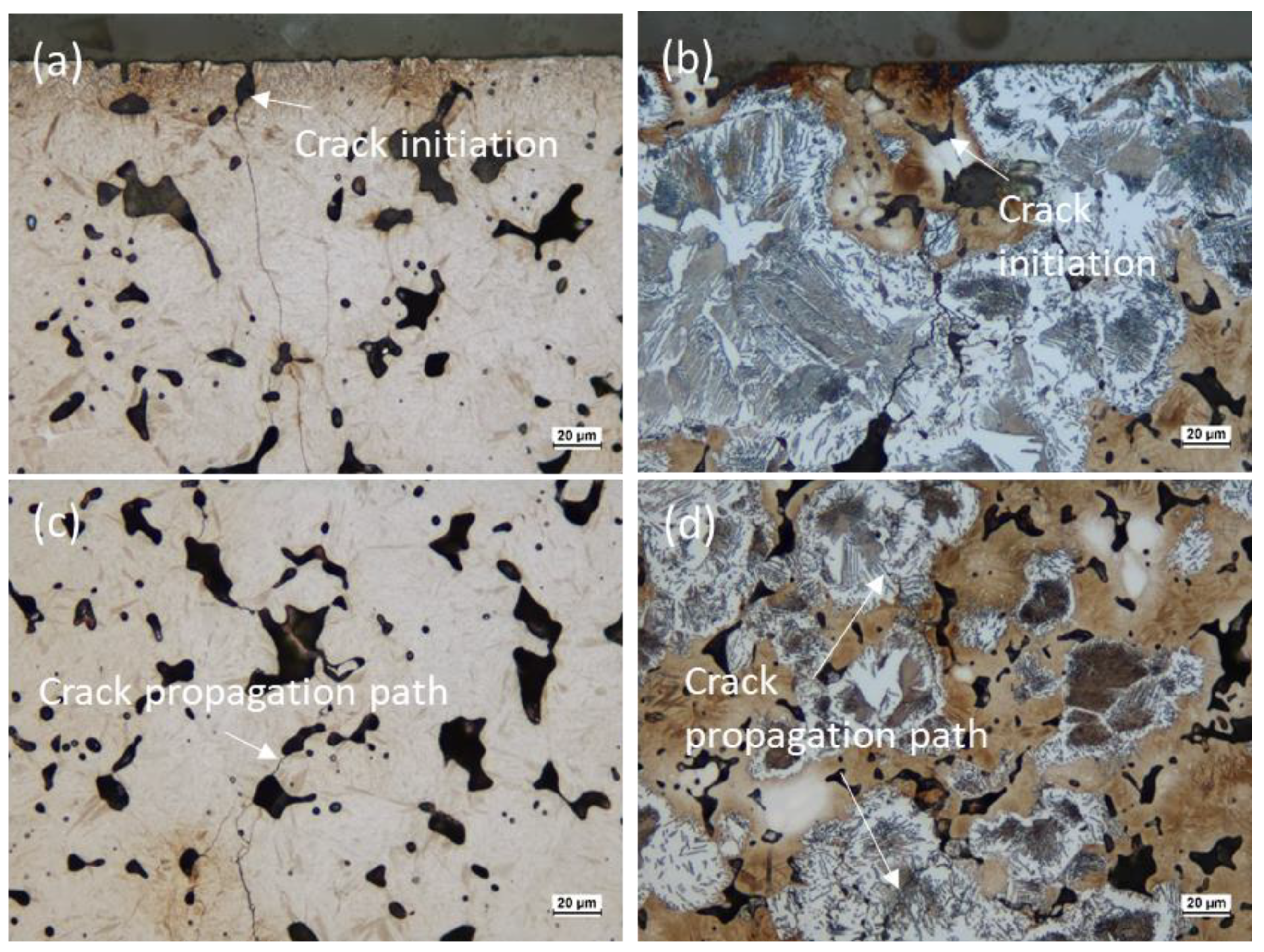
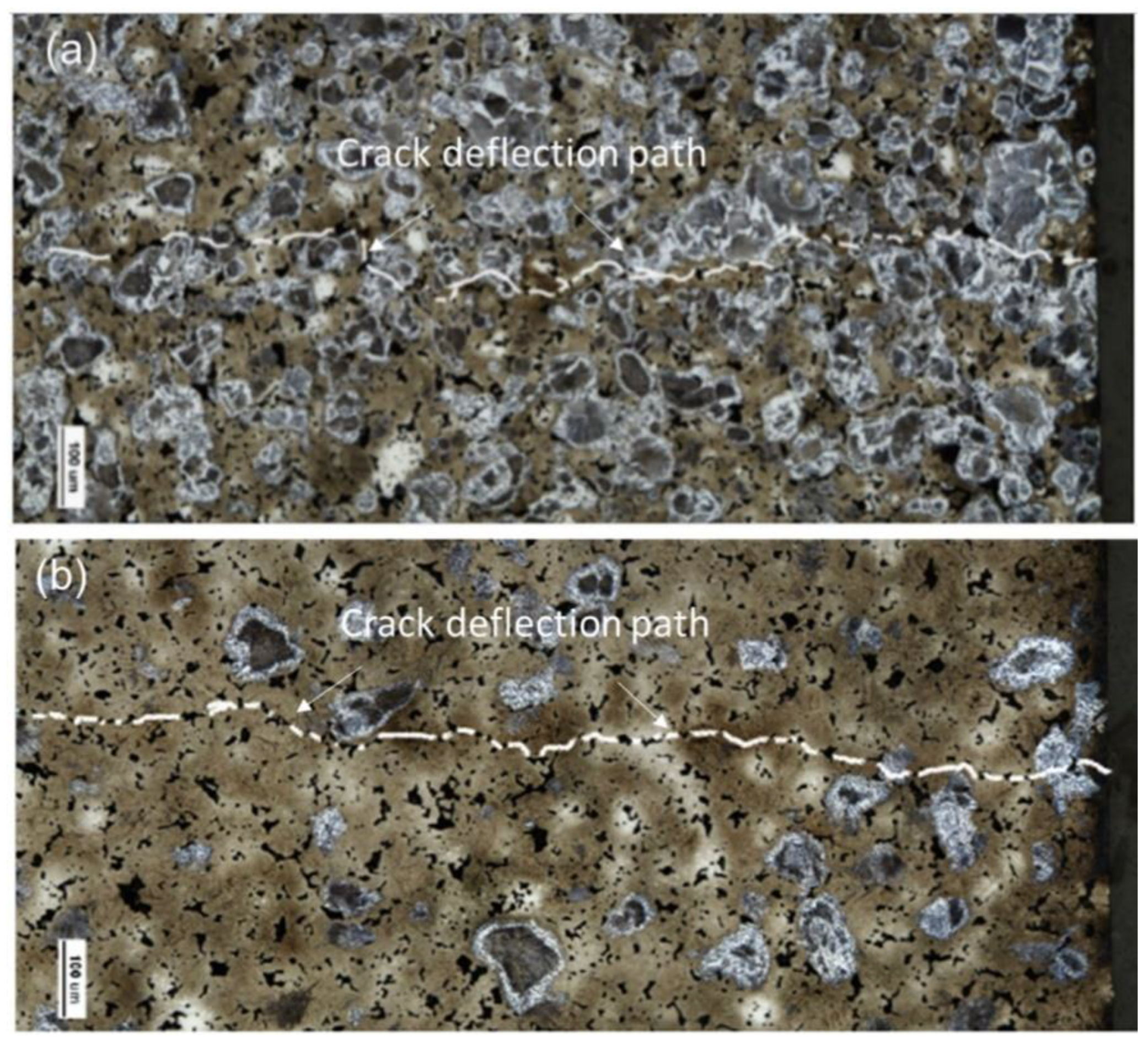
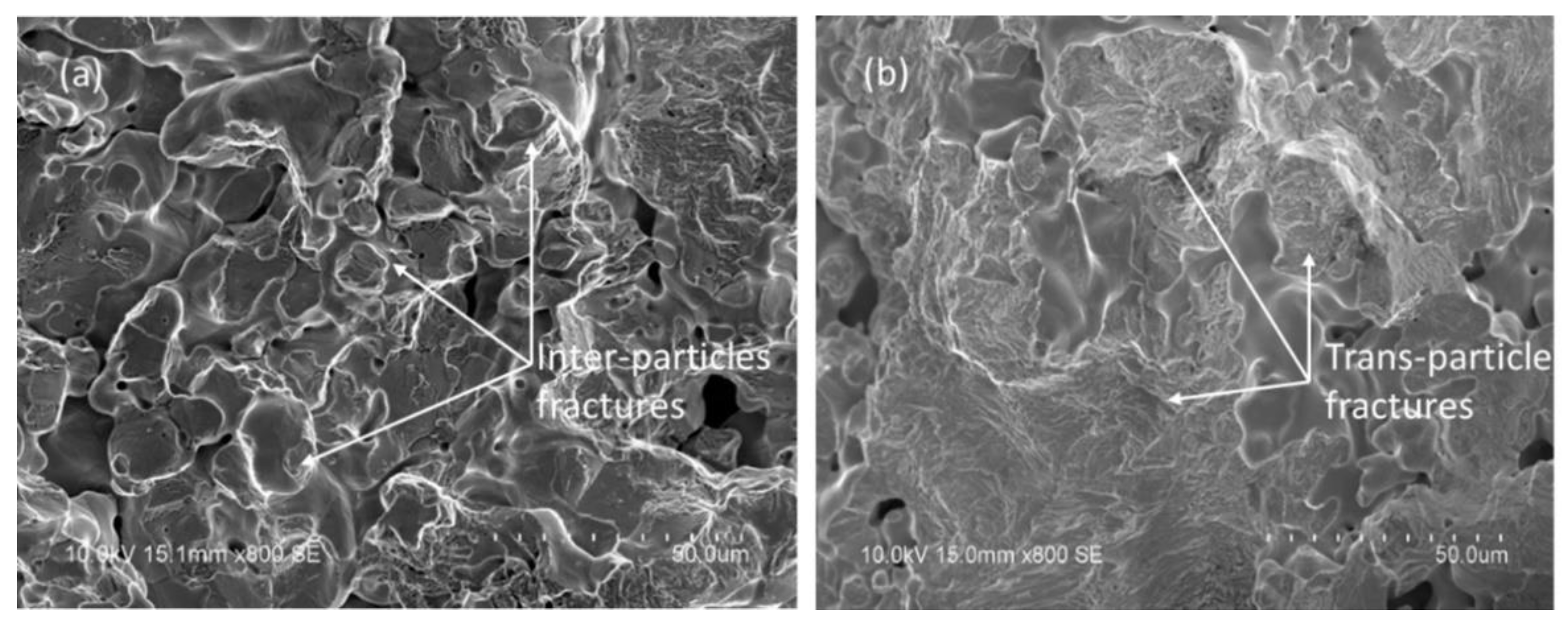
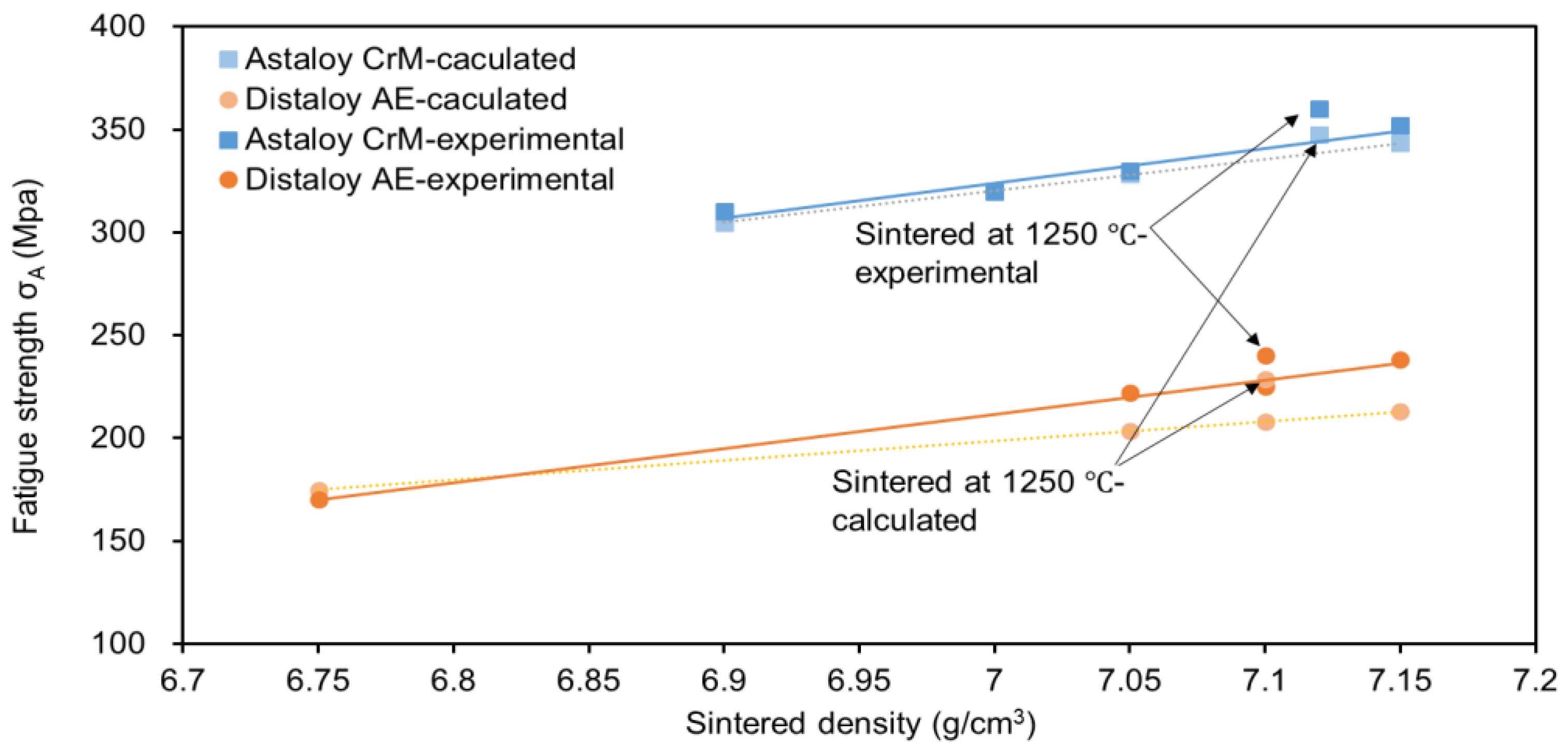
| Alloy Steel | Cr (wt.%) | Mo (wt.%) | Cu (wt.%) | Ni (wt.%) | Fe (wt.%) |
|---|---|---|---|---|---|
| Astaloy CrM | 3.0 | 0.5 | - | - | Bal. |
| Distaloy AE | - | 0.5 | 1.5 | 4.0 | Bal. |
| Sample | Average Roundness (µm) | ||
|---|---|---|---|
| CrM-1120 | 64.3 | 3892 | 2.1 |
| CrM-1250 | 50.1 | 3940 | 1.8 |
| AE-1120 | 77.5 | 4749 | 2.0 |
| AE-1250 | 73.3 | 4242 | 1.8 |
Publisher’s Note: MDPI stays neutral with regard to jurisdictional claims in published maps and institutional affiliations. |
© 2022 by the authors. Licensee MDPI, Basel, Switzerland. This article is an open access article distributed under the terms and conditions of the Creative Commons Attribution (CC BY) license (https://creativecommons.org/licenses/by/4.0/).
Share and Cite
Tan, Z.; Liu, Y.; Huang, X.; Li, S. Fatigue Behavior of Alloy Steels Sintered from Pre-Alloyed and Diffusion-Bonding Alloyed Powders. Metals 2022, 12, 659. https://doi.org/10.3390/met12040659
Tan Z, Liu Y, Huang X, Li S. Fatigue Behavior of Alloy Steels Sintered from Pre-Alloyed and Diffusion-Bonding Alloyed Powders. Metals. 2022; 12(4):659. https://doi.org/10.3390/met12040659
Chicago/Turabian StyleTan, Zhaoqiang, Yong Liu, Xiaolin Huang, and Songlin Li. 2022. "Fatigue Behavior of Alloy Steels Sintered from Pre-Alloyed and Diffusion-Bonding Alloyed Powders" Metals 12, no. 4: 659. https://doi.org/10.3390/met12040659
APA StyleTan, Z., Liu, Y., Huang, X., & Li, S. (2022). Fatigue Behavior of Alloy Steels Sintered from Pre-Alloyed and Diffusion-Bonding Alloyed Powders. Metals, 12(4), 659. https://doi.org/10.3390/met12040659






